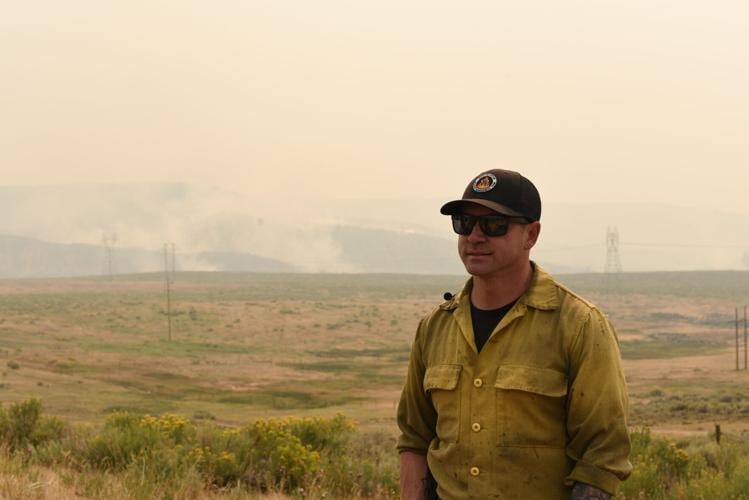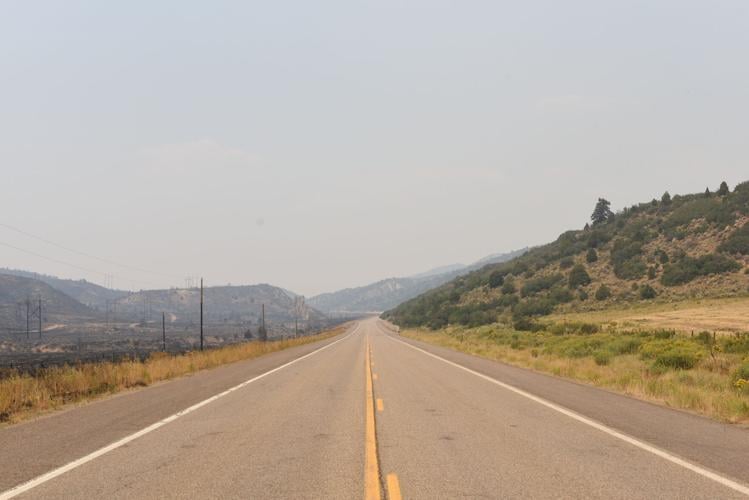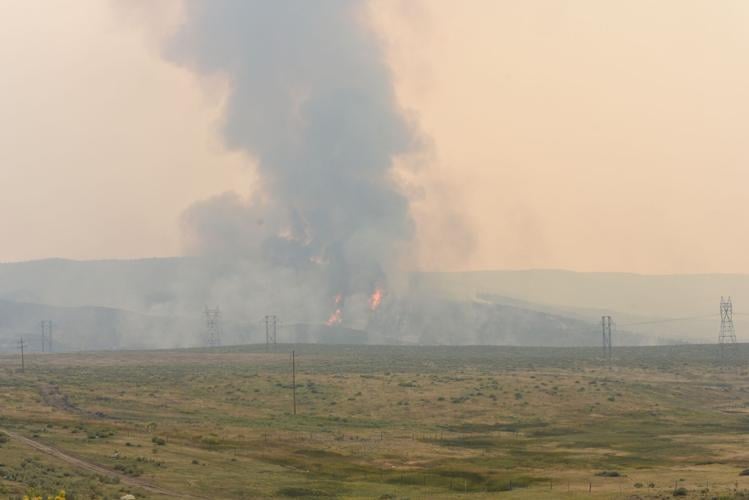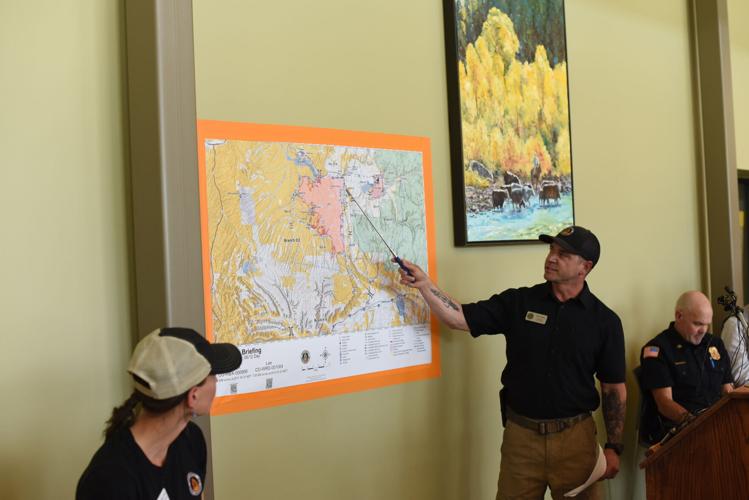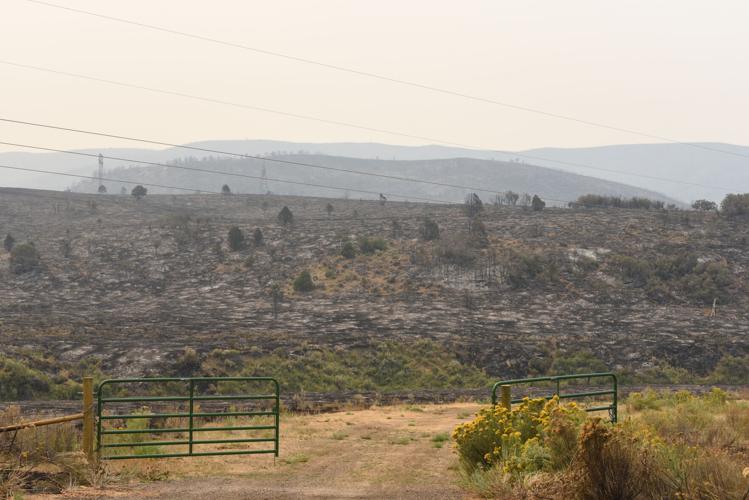Officials optimistic as Lee fire nears 117,000 acres
Scattered clouds were supposed to dot the skies above Highway 13 south of Craig Tuesday afternoon, but they were hardly visible beyond the distinct haze that had settled into the valley.
Ahead, the rolling hills of the Western Slope, beige and dotted with green brush, were visible only as silhouettes through the smoke. Few people were driving in either direction between Craig and its southern neighbor, Meeker; the roadway played host to more magpies than vehicles.
For the last week and a half, Colorado’s western region has been under threat from the Lee fire. Now the fifth largest recorded wildfire in state history, the blaze grew to nearly 117,000 acres Monday night, a significant uptick from its initial 700-acre estimation.
Lee fire grows to 5th largest in Colorado history
“A lot of us (initially) came in and went ‘OK, we can grab this,” said Tyler Nathe, operations section chief with Rocky Mountain Area Complex Incident Management Team 3, at a news conference in Meeker Tuesday afternoon. “Then it made a 30,000-acre run in one day and we all took a step back.”
The Lee fire has been different than others of its ilk, Nathe said. While many brush-based fires tend to lay down when the wind drops, the abundance of drought-stricken vegatation and a continuous, six-week-long red flag warning prolonged the blaze and made it more extreme than usual.
“We haven’t seen this type of fire behavior and this type of fuel model for a long time, and maybe if ever,” Nathe said. “(It’s) kind of unprecedented, regarding this type of fuel.”
Directly southwest of Meeker — the area currently overtaken by the Lee fire — is home to a significant amount of Bureau of Land Management oil and gas infrastructure that officials believe has remained mostly intact amidst the fire, said BLM White River Field Office Manager Bill Mills at the news conference Tuesday.
“Part of our permitting activity for oil and gas are design features for oil and gas pads, and what we’ve seen time and time again throughout this fire is that those design features have proven successful,” Mills said. “We’ll have to do an assessment when the fire is (gone), but what we’ve seen so far is that those design features have been very, very successful.”
The response to the fire has generated a swath of resources from local, state and federal authorities. Multiple regional and county officials noted their collaboration on emergency efforts.
One representative from the state — Sam Parsons, agency administrator for the Colorado Division of Fire Prevention and Control — was also present, noting both Colorado’s financial assistance and providing multiple helicopters and fixed-wing aircraft to help fight the flames.
Additionally, Rio Blanco County Commissioner Doug Overton noted that Gov. Jared Polis’ emergency declaration allowed the affected areas to access federal funding to help with the mitigation and relief work. Overton also said that the county was working on bringing in a fiscal agent to provide financial aid to those affected by the fire, but that they would make a more official announcement with details after a contract had been signed.
Despite the wide range of resources helping combat the fires, Meeker nearly fell victim to the blaze just days ago.
Last week, the Lee fire jumped across Highway 13, moving from an area contained by a dozer line into an uncontained region less than a half mile south of the town.
Meeker self-evacuates as Elk and Lee fires grow to 75,000 combined acres
Most of the town had already self-evacuated due to the fire’s imminent threat, but structures along its south side were a stone’s throw away from the flames, officials said Tuesday.
Up to that point, crews had been using mostly indirect efforts — plowing dozer lines and burning vegetation around the fire’s perimeter — to help isolate the blaze from new sources of fuel, Nathe said. The strategy was based on a lack of slow-burning fuel in the area, and effectively worked to push the fire back into itself and ultimately burn out.
“(The fuels) combined with the weather conditions create near-impossible conditions for us to do what we would normally in being effective and direct,” Nathe said. “It’s a pretty challenging environment and it wants to move.”
But with a part of the fire now in an area both uncontained and within striking distance of the town, responders used direct measures to keep the flames at bay while others worked to build a dozer line in the process, officials said.
A switch in the direction of the wind allowed crews to better quell the fire before it ever reached the town, officials added. Now, they no longer believe Meeker is under any remaining threat.
Elk and Lee fires top 100,000 acres but Meeker no longer under immediate threat
The area along Meeker is the only section of the Lee fire that has reached containment, which officials estimated at 6% Tuesday.
After fortifying the lines bordering Meeker in the days after the fire threatened the town, crews then turned their attention to the southwest end of the blaze, Nathe said. The winds had changed direction, and the fire was now moving in the southern direction toward Rifle.
The south end of the Lee fire is where personnel have been focusing their efforts for the past few days, Nathe said, with any new acreage being mostly the blaze filling in its own interior.
In the coming days, officials expect the winds to turn back in the northernmost direction toward Meeker. But with little fuel remaining in that direction, they are not concerned about the fires impacting the town again.
“We’re feeling really good about everything up here on this north end, so a couple days from now, whenever the weather decides to shift around and we have that wind coming back in here, I have no concerns about the community of Meeker,” Nathe said. “Some of what that will allow us to do down (south) as well is it’ll blow the fire back into itself, which helps us.”
In total, the Lee fire has claimed three residential buildings and 12 other buildings so far, Rio Blanco County Sheriff Anthony Mazzola confirmed Tuesday. A total of 840 people were in the “go” evacuation zones — the most extreme evacuation protocol — at the height of the fire.
“It’s been amazing to watch the support of the town coming together, working together with our federal partners to fight these fires and with our state,” Mazzola said. “It’s been wild, it’s been scary, but we’re a rural county. We bond together, we work together.”






